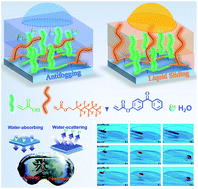UV curable stimuli-responsive coatings with antifogging and oil-repellent performances†
Abstract
Antifogging coatings prepared by highly hydrophilic/superhydrophilic strategies are susceptible to general oil contamination, hence readily losing their activities. Herein, a stimuli-responsive antifogging/oil-repellent coating with a delicate balance between hydrophilic and oleophobic components was prepared via a UV-assisted cross-linking method. Initially, different contents of acrylate monomers, including acrylic acid (AA), 1H,1H,2H,2H-tridecafluoro-n-octyl acrylate (TFOA), and 4-benzoylphenyl acrylate (BPA) were thermally polymerized to obtain a series of terpolymers, poly(AA-co-TFOA-co-BPA). Afterwards, poly(AA-co-TFOA-co-BPA) was covalently tethered to varied substrate surfaces (i.e., glass slides, PC, PET, and PVC) through a UV triggered anchoring of BPA. Benefiting from the delicate balance between hydrophilic poly(AA) and oleophobic poly(TFOA), the resultant coating displays solvent sensitive stimuli-responsive wettability, driven by the encountered liquids with different surface tensions. Therefore, these coatings show excellent anti-fogging ability with ∼90% light transmission, in a wide temperature range from −20 °C to 85 °C, meanwhile, the coatings also display remarkably high oil-repellence with an extremely low sliding angle for low tension liquids. These findings support the development of functional coatings that can highly maintain antifogging performances while effectively avoiding oil contamination in various imaging, medical and analytical applications.

- This article is part of the themed collection: Polymers in liquid formulations


 Please wait while we load your content...
Please wait while we load your content...